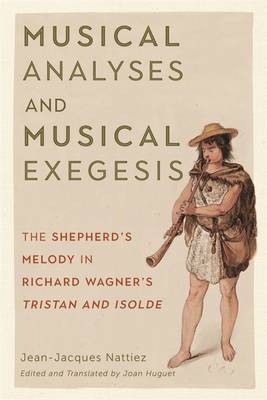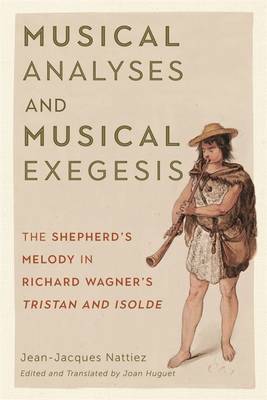
- Afhalen na 1 uur in een winkel met voorraad
- Gratis thuislevering in België vanaf € 30
- Ruim aanbod met 7 miljoen producten
- Afhalen na 1 uur in een winkel met voorraad
- Gratis thuislevering in België vanaf € 30
- Ruim aanbod met 7 miljoen producten
Zoeken
Musical Analyses and Musical Exegesis
The Shepherd's Melody in Richard Wagner's Tristan and Isolde
Jean-Jacques Nattiez
€ 257,95
+ 515 punten
Omschrijving
The field of musicology has in recent decades branched out to incorporate methods from a wide range of other fields. But, when scholars examine a musical work, to what extent should they emphasize immanent (purely internal) features, and to what extent historical, cultural, psychological, or aesthetic networks of meanings associated with those features? Finally, what specific analytical method should be chosen, given that various methods can lead to seemingly incompatible results?
Jean-Jacques Nattiez, a renowned figure in music theory, musicology, and ethnomusicology, here examines numerous contending approaches that have been applied to the English-horn melody heard in Wagner's Tristan and Isolde. His aim is to offer thereby a methodological guide and compendium that will allow specialists and students alike to navigate the multiplicity of theoretical orientations in musicology.
Analytical models proposed by Heinrich Schenker, Nicolas Ruwet, Leonard B. Meyer, Fred Lerdahl, and other notable figures in the field of music analysis are discussed. Some of the analytical sketches by these scholars were previously unpublished and are presented to the public for the first time in the present book. The author also considers insights from the fields of psychology and psychoanalysis. An examination of Wagner's wide-ranging musical sources (Venetian gondolier songs and Swiss shepherd songs) leads to acutely relevant passages in writings by Rousseau, Goethe, and Schopenhauer. The book culminates in Nattiez's own interpretation of the relationship between vocal and instrumental music in Tristan and Isolde. Jean-Jacques Nattiez is professor emeritus of musicology at the Université de Montréal.
Jean-Jacques Nattiez, a renowned figure in music theory, musicology, and ethnomusicology, here examines numerous contending approaches that have been applied to the English-horn melody heard in Wagner's Tristan and Isolde. His aim is to offer thereby a methodological guide and compendium that will allow specialists and students alike to navigate the multiplicity of theoretical orientations in musicology.
Analytical models proposed by Heinrich Schenker, Nicolas Ruwet, Leonard B. Meyer, Fred Lerdahl, and other notable figures in the field of music analysis are discussed. Some of the analytical sketches by these scholars were previously unpublished and are presented to the public for the first time in the present book. The author also considers insights from the fields of psychology and psychoanalysis. An examination of Wagner's wide-ranging musical sources (Venetian gondolier songs and Swiss shepherd songs) leads to acutely relevant passages in writings by Rousseau, Goethe, and Schopenhauer. The book culminates in Nattiez's own interpretation of the relationship between vocal and instrumental music in Tristan and Isolde. Jean-Jacques Nattiez is professor emeritus of musicology at the Université de Montréal.
Specificaties
Betrokkenen
- Auteur(s):
- Vertaler(s):
- Uitgeverij:
Inhoud
- Aantal bladzijden:
- 470
- Taal:
- Engels
- Reeks:
- Reeksnummer:
- nr. 180
Eigenschappen
- Productcode (EAN):
- 9781580469999
- Verschijningsdatum:
- 15/05/2021
- Uitvoering:
- Hardcover
- Formaat:
- Genaaid
- Afmetingen:
- 152 mm x 229 mm
- Gewicht:
- 793 g

Alleen bij Standaard Boekhandel
+ 515 punten op je klantenkaart van Standaard Boekhandel
Beoordelingen
We publiceren alleen reviews die voldoen aan de voorwaarden voor reviews. Bekijk onze voorwaarden voor reviews.











